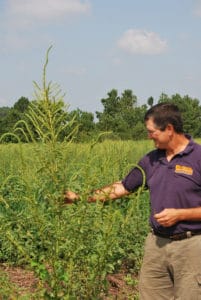Cornucopia’s Take: Palmer amaranth, a ‘super weed’ resistant to several herbicides, has been inadvertently introduced to Conservation Reserve Program land via contaminated pollinator seed mixes. The weed has evolved resistance through continual herbicide applications and poses a threat to industrial agriculture. Blowtorches, allowed in organic production, may prove more effective than conventional controls.
Invasive ‘super weed’ spreads through Iowa
The Des Moines Register
by Donelle Eller
 |
Delaware Carvel REC |
Linda Huff’s Dodge minivan is filled with garbage bags stuffed with Palmer amaranth she dug up this fall from 20 acres planted with prairie grasses and flowers near Jefferson.
It took the 77-year-old about 15 hours to remove the plants, which can quickly grow up to 7 feet tall. She carefully placed flags where she removed each plant, knowing seeds from the highly invasive weed could easily sprout again next spring, moving from field to field, crowding out corn, soybeans and other cash crops.
Farmers in Iowa, Minnesota and some other Midwestern states have learned that the native grasses and prairies planted to help butterflies and other pollinators inadvertently have spread the noxious weed. It has overrun and choked fields across the southern United States, where it has proved resistant to several herbicides, including widely used glyphosate.

